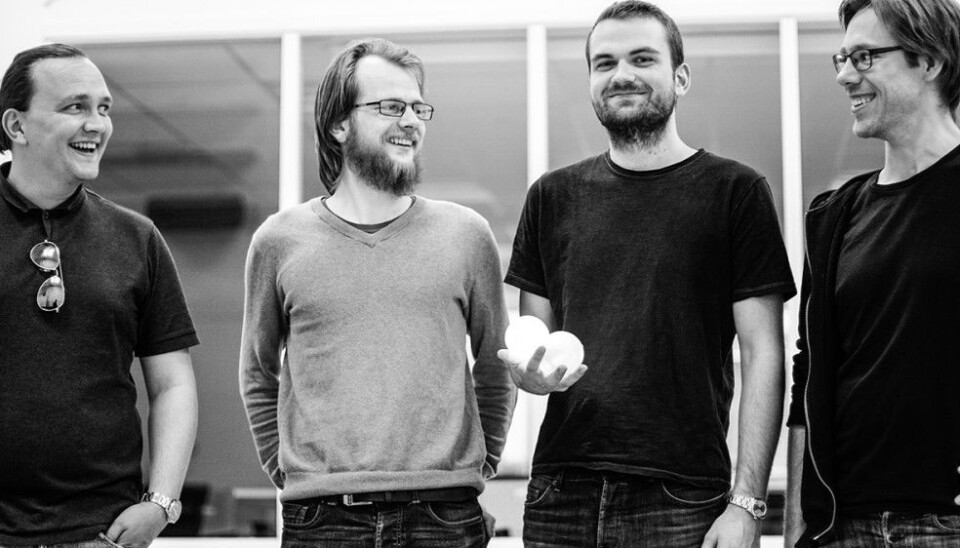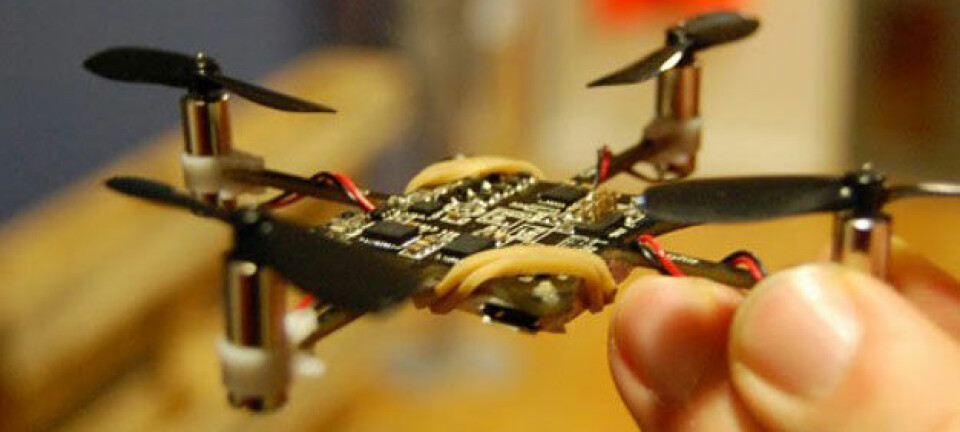
These juggling balls are the result of clever engineering
Jugglers learn new patterns – and engineering students gravitate toward a Newtonian challenge.
Illuminated balls whirl around the darkened room. A juggler has control.
The spheres change colours, first in response to the paths they are taking and then in response to how high they fly. They form a rainbow over the nimble hands. But this man is not a circus artist.
Jan Dyre Bjerknes works four days a week as an engineer at Kongsberg Defence & Aerospace – with projectiles that fly far faster and higher than these juggling balls.
New tricks
But on the fifth weekday he has completely different tasks. Here at the University College of Southeast Norway in Kongsberg he gives engineering students assignments that are closer to the ground. But this doesn’t make the challenges mundane.
For example: How to show off the path traversed by the juggling balls? How can they help a juggler to see the balls correctly?
This can be educational for the curious viewer, for the fresh beginner and the seasoned artist who wants to learn some new tricks – new patterns that have never before been attempted in the 4,000 years of juggling history.
Jan Dyre Bjerknes demonstrates a standard juggling pattern with three balls, viewed in slow motion. All the balls light up white. This means the juggler is doing things right.
Light-Swappers
Four electrical engineering students were given the assignment. The result was the start-up firm Stochastical Dynamics – and a dream of what might become a commercial product called Light-Swappers.
Håkon Landmark, Johannes Wågen, Johan Rønbeck and Jakob Pein didn’t have much time on their hands. In the course of six months they had to make a prototype of luminous balls that “know” where they are and what they are doing.
Mobile phone parts
Johannes Wågen opens one of the Light-Swapper balls. He unscrews the two halves of 3D-printed plastic from one another. What’s inside?
Among other things the same type of electronics found in mobile phones to count strides. The accelerometer measures – as the name says – acceleration.
When the juggler tosses the ball in the air it speeds up while in his hand. It is a sudden acceleration registered by the accelerometer.
The ball curves though the air. It falls, weightless in its descent. The accelerometer measures zero until the ball is caught and tossed up once again.
Johannes Wågen demonstrates the most important components inside the balls.
Communication by radio
But wait a second – the accelerometer only registers the movement of one ball. What are the others doing?
The balls need to process information about one another. They communicate their positions and trajectories by radio waves. They tell one another about their acceleration and paths.
Tiny radio transmitters and receivers do that job. It is starting to get cramped inside the plastic spheres. But more has to be squeezed in.
Gyroscope prevents spinning errors
The balls also have to fit well in the hand. They need to be good to throw and their centre of gravity should be dead centre.
The heaviest components are the batteries. So with these at the core the accelerometer is positioned a little toward the edge.
What if the ball rotates? The accelerometer spins around too, like in a centrifuge. That slings it outward, screwing up the acceleration measurements.
The ball needs to measure any rotation and subtract the error from the measurements. A gyroscope takes care of that. Of course this takes even more space.
Balls that think on their own
Eight LED lights can together make over 16 million different nuances of colour. But the ball isn’t fully packed yet. More is needed to make it work.
It isn’t enough for the balls to communicate with one another by radio, exchanging information about their positions, speeds and trajectories. They need to know what they are talking about – what these measurements mean.
What juggling pattern are the balls following? They need to know what’s happening in real time.
Micro-controllers also have places inside the balls. These are tiny computers. The students have written the software they use.
“All the calculations are performed within the balls. We don’t need to use a PC or any other external support systems. We are alone in this,” says Johan Rønbeck.
Juggling and math
The computer software uses the accelerometer to measure the time between each upward thrust of the ball – and how long it falls weightless before being caught again.
The computer program finds out how the balls are moving using solely these measurements. How?
To the rescue comes Claude Shannon, a father of information technology. He too was a juggler and could keep four balls in motion. He devised a theory for juggling in the 1980s.
He showed the relationship between the number of balls, the number of hands in action and the time the balls were in the air or in the hands, and how long the hands were at rest.
Not really a subject for someone with math anxiety?
Juggling, robots and the human body
Yes indeed, asserts Jan Dyre Bjerknes. He lectures to the general public as well as for scientists. The luminous balls are great for informing and wowing the public. The theories behind the juggling patterns can help provide “aha!” reactions about mathematics.
“I think it’s important to get across that math is about something much finer and nobler than adding and subtracting, multiplying and dividing. It’s about truth and abstraction,” explains Bjerknes.
Abstraction allows you to see that things which apparently have nothing to do with one another can be connected on a higher plane as well as put to practical use.
For instance – the movements of the juggling balls and Claude Shannon’s theories. Can they also be used to discover how robots can get better control of arms and legs – or do so for amputees?
Jan Dyre Bjerknes’s lecture What exactly is mathematics? Here he explains more of the theories at the heart of the luminous juggling balls.
Juggling against math anxiety
Shannon’s theories also point toward pure mathematics – for example numbers theories.
“I find it frightfully exciting and attractive and I love to share my fascination,” says Bjerknes.
He juggles and explains to audiences in assembly halls how math can be exciting and provide deep understanding.
These luminous juggling balls make his lectures all the more enlightening.
“The boys at Stochastical Dynamics have fabricated a set of balls for me and I have a new tool for sharing ideas which deserve attention,” says Bjerknes.
Shock learning
“Four poor electro-engineers have had plenty of worries along the way,” says Johan Rønbeck.
“But we managed to solve most of these,” stresses Jakob Pein.
Their exam project confirms this. Here are 413 pages of heavy product development – shock-learning in six months.
It covers project and financial management, their own organisation and division of roles, risk analyses, readjustments made as they went along. These are all things an engineer will encounter working in the industry.
The students received their due rewards for their tribulations: They won the prize for the best technical solution at the university college.
Juggling during breaks
When their own scientific expertise fell short the four got outside help. A 3D drawing and printing of the ball was made in collaboration with, among others, Bård Rønbeck, the Technology Garage in Kongsberg, Canon and Adlab at the Norwegian University of Science and Technology (NTNU).
The professional juggler Brian Opedal also helped out the students.
“He could juggle steadily in the patterns we asked for,” says Rønbeck. This enabled the students to analyse the patterns, also using with video recordings.
As the project rolled along they learned some juggling tricks themselves.
“This proved to be a brilliant activity during breaks,” says Rønbeck.
-------------------------------------
Read the Norwegian version of this article at forskning.no
Translated by: Glenn Ostling
































